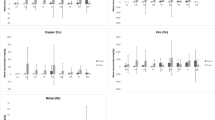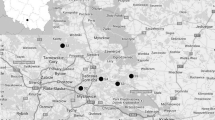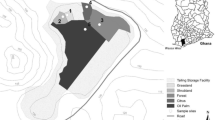Abstract
Arsenic and heavy metal (specifically Cd, Cr, Cu, Ni, Pb, and Zn) uptake, translocation, and accumulation in ten native plant species spontaneously growing in soils polluted by mining activities were studied, with a focus on future phytoremediation work in polluted soils. Plant and soil samples were collected in the vicinity of the Mónica mine (NW Madrid, Spain). Soil analysis showed the ability of native plants for growing in soils with high concentration levels of Cd, Cu, Pb, Zn, and especially As. From these elements, the highest percentage of extractable elements was found for Cd and the lowest for Pb. A highly significant correlation was observed between total and extractable element concentrations in soils, except for Cu, indicating that total concentration is the most relevant factor for element mobility in these soils. Extractable elements in soils were better correlated with concentrations in plants than total elements in soils; thus, extraction methods applied are suitable to estimate the element phytoavailable fraction in soils, which depends on the plant species and not only on the element mobility in soils. High element concentrations were found in the aboveground parts of Corrigiola telephiifolia (As and Pb), Jasione montana (Cd and Zn), and Digitalis thapsi (As, Cd, Cu, Pb and Zn). However, considering the translocation and accumulation factors, together with the concentration levels found in roots and aboveground parts, only C. telephiifolia could be considered a Pb accumulator and an As hyperaccumulator plant, which could be used for future phytoremediation work in soils polluted with As.




Similar content being viewed by others
References
Adriano, D. C. (2001). Trace elements in the terrestrial environment. Biogeochemistry, bioavailability and risks of metals (2nd ed.). New York: Springer.
Alkorta, I., Hernández-Allica, J., Becerril, J. M., Amezaga, I., Albizu, I., & Garbisu, C. (2004). Recent findings on the phytoremediation of soils contaminated with environmentally toxic heavy metals and metalloids such as Zn, Cd, Pb, and As. Reviews in Environmental Science and Biotechnology, 3, 71–90.
Alvarenga, P. M., Araújo, M. F., & Silva, J. A. L. (2004). Elemental uptake and root-leaves transfer in Cistus ladanifer L. growing in a contaminated pyrite mining area (Aljustrel-Portugal). Water, Air, and Soil Pollution, 152, 81–96.
Anawar, H. M., García-Sánchez, A., & Santa Regina, I. (2008). Evaluation of various chemical extraction methods to estimate plant-available arsenic in mine soils. Chemosphere, 70, 1459–1467.
Antosiewicz, D. M., Escudĕ-Duran, C., Wierzbowska, E., & Skłodowska, A. (2008). Indigenous plant species with the potential for the phytoremediation of arsenic and metals contaminated soils. Water, Air, and Soil Pollution, 193, 197–210.
Baker, A. J. M. (1981). Accumulators and excluders–strategies in the response of plants to heavy metals. Journal of Plant Nutrition, 3, 643–654.
Bhattacharya, P., Welch, A. H., Stollenwerk, K. G., McLaughlin, M. J., Bundschuh, J., & Panaullah, G. (2007). As in the environment: biology and chemistry. Science of the Total Environment, 379, 109–120.
Butcher, D. J. (2009). Phytoremediation of arsenic: fundamental studies, practical applications, and future prospects. Applied Spectroscopy Reviews, 44(6), 534–551.
Conesa, H. M., Robinson, B. H., Schulin, B., & Nowack, B. (2008). Metal extractability in acidic and neutral mine tailings from the Cartagena-La Unión Mining District (SE Spain). Applied Geochemistry, 23, 1232–1240.
Farago, M. E., & Merha, A. (1991). Uptake of elements by the copper-tolerant plant Armeria maritime. In: Merian E. (ed.) Metal compounds in environment and life–interrelation between chemistry and biology 4 (pp. 163–169).
García-Salgado, S., Quijano-Nieto, M. A., & Bonilla-Simón, M. M. (2009). Análisis multielemental mediante ICP-AES de plantas autóctonas procedentes de la zona minera de Bustarviejo (Madrid). Ministerio de Medio Ambiente y Medio Rural y Marino, Iberolab Libro de Comunicaciones, V Congreso Virtual Iberoamericano sobre Gestión de Calidad en Laboratorios, 361–366 (http://www.iberolab.org).
Gisbert, C., Almela, C., Vélez, D., López-Moya, J. R., de Haro, A., Serrano, R., Montoro, R., & Navarro-Aviñó, J. (2008). Identification of As accumulation plant species growing on highly contaminated soils. International Journal of Phytoremediation, 10, 185–196.
González del Tanago-Chanrai, J., & González del Tanago-del Río, J. (2002). Minerales y minas de Madrid. Madrid: Mundi-Prensa.
Haque, N., Peralta-Videa, J. R., Jones, G. L., Gill, T. E., & Gardea-Torresdey, J. L. (2008). Screening the phytoremediation potential of desert broom (Baccharis sarothroides Gray) growing on mine tailings in Arizona, USA. Environmental Pollution, 153, 362–368.
Houba, V. J. G., Temminghoff, E. J. M., Gaikhorst, G. A., & van Vark, W. (2000). Soil analysis procedures using 0.01 M calcium chloride as extraction reagent. Communications in Soil Science and Plant Analysis, 31(9&10), 1299–1396.
Jiménez, R., Jordá, L., Jordá, R., & Prado, P. (2004). Madrid. La minería metálica desde 1417 hasta nuestros días. Bocamina, 14, 50–89.
Kabata-Pendias, A. (2001). Trace elements in plants. In A. Kabata-Pendias (Ed.), Trace elements in soils and plants (3rd ed., pp. 73–98). Boca Raton: CRC Press.
Kabata-Pendias, A. (2004). Soil-plant transfer of trace elements–an environmental issue. Geoderma, 122, 143–149.
Lambrechts, T., Couder, E., Bernal, M. P., Faz, A., Iserentant, I., & Lutts, S. (2011). Assessment of heavy metal bioavailability in contaminated soils from a former mining area (La Union, Spain) using a rhizospheric test. Water, Air, and Soil Pollution, 217, 333–346.
Lasat, M. M. (2002). Phytoextraction of toxic metals: a review of biological mechanisms. Journal of Environmental Quality, 31, 109–120.
Mahmud, R., Inoue, N., Kasajima, S., & Shaheen, R. (2008). Assessment of the potential indigenous plant species for the phytoremediation of arsenic contaminated areas of Bangladesh. International Journal of Phytoremediation, 10, 119–132.
MAPA (1994). Determinación de carbono orgánico oxidable. Métodos oficiales de análisis de suelos y aguas para riego, Vol. III. Ministerio de Agricultura, Pesca y Alimentación. Madrid, Spain, pp. 281–283.
Menzies, N. W., Donn, M. J., & Kopittke, P. M. (2007). Evaluation of extractants for estimation of the phytoavailable trace metals in soils. Environmental Pollution, 145, 121–130.
Moreno-Jiménez, E., Manzano, R., Esteban, E., & Peñalosa, J. (2010). The fate of arsenic in soils adjacent to an old mine site (Bustarviejo, Spain): mobility and transfer to native flora. Journal of Soils and Sediments, 10, 301–312.
Moreno-Jiménez, E., Peñalosa, J. M., Manzano, R., Carpena-Ruíz, R. O., Gamarra, R., & Esteban, E. (2009). Heavy metals distribution in soils surrounding an abandoned mine in NW Madrid (Spain) and their transference to wild flora. Journal of Hazardous Materials, 162, 854–859.
ORD 2770/2006 MAD (2006) Orden 2770/2006, de 11 de agosto, Consejería de Medio Ambiente y Ordenación del Territorio, Comunidad de Madrid, B.O.C.M. Núm. 204, Lunes 28 de agosto de 2006. pp. 29–30.
Padmavathiamma, P. K., & Li, L. Y. (2007). Phytoremediation technology: hyper-accumulation metals in plants. Water, Air, and Soil Pollution, 184, 105–126.
Pastor, J., García-Salgado, S., Hernández, A. J., Quijano-Nieto, M. A., & Bonilla-Simon, M. M. (2008). Arsénico y otros metales pesados en plantas de comunidades de pastos del cerro de la plata (Bustarviejo, Madrid). In: Fernández, P. et al. (Eds.) Pastos, clave en la gestión de los territorios. Consejería de Agricultura y Pesca, Junta de Andalucía (pp. 91–97).
Pastor, J., & Hernández, A. J. (2008). Contenidos de metales pesados en gramíneas de ecosistemas desarrollados sobre antiguas minas abandonadas de Madrid y Castilla-La Mancha. 9°Congreso Nacional del Medio Ambiente.
Pilon-Smits, E. A. H. (2005). Phytoremediation. Annual Review of Plant Biology, 56, 15–39.
Pueyo, M., López-Sánchez, J. F., & Rauret, G. (2004). Assessment of CaCl2, NaNO3 and NH4NO3 extraction procedures for the study of Cd, Cu, Pb and Zn extractability in contaminated soils. Analytica Chimica Acta, 504, 217–226.
Pueyo, M., Sahuquillo, A., Rigol, A., López-Sánchez, J. F., & Rauret, G. (2005). A new quality control soil material for monitoring trace metals in accidentally polluted areas. Analytica Chimica Acta, 533, 41–49.
Rao, C. R. M., Sahuquillo, A., & López Sanchez, J. F. (2008). A review of the different methods applied in environmental geochemistry for single and sequential extraction of trace elements in soils and related materials. Water, Air, and Soil Pollution, 189, 291–333.
Sahuquillo, A., Rigol, A., & Rauret, G. (2003). Overview of the use of leaching/extraction tests for risk assessment of trace metals in contaminated soils and sediments. TrAC Trends in Analytical Chemistry, 22, 152–159.
Sridhar, B. B. M., Han, F. X., Diehl, S. V., Monts, D. L., & Su, Y. (2007). Monitoring the effects of As and Cr accumulation in Chinese brake fern (Pteris vittata). International Journal of Remote Sensing, 28, 1055–1067.
Takeda, A., Tsukada, H., Takaku, Y., Hisamatsu, S., Inaba, J., & Nanzyo, M. (2006). Extractability of major and trace elements from agricultural soils using chemical extraction methods: application for phytoavailability assessment. Soil Science and Plant Nutrition, 52(4), 406–417.
UNE 103-300 (1993) Determinación de la humedad de un suelo mediante secado en estufa.
UNE 77305 (1999) Calidad del suelo: Determinación del pH.
UNE 77308 (2001) Calidad del suelo: Determinación de la conductividad eléctrica específica.
Vamerali, T., Bandiera, M., & Mosca, G. (2010). Field crops for phytoremediation of metal-contaminated land. A review. Environmental Chemistry Letters, 8, 1–17.
Warren, G. P., Alloway, B. J., Lepp, N. W., Singh, B., Bochereau, F. J. M., & Penny, C. (2003). Field trials to assess the uptake of arsenic by vegetables from contaminated soils and soil remediation with iron oxides. Science of the Total Environment, 311, 19–33.
Zhao, F. J., Ma, J. F., Meharg, A. A., & McGrath, S. P. (2009). Arsenic uptake and metabolism in plants. The New Phytologist, 181, 777–794.
Acknowledgments
This work was financially supported by the Universidad Politécnica de Madrid (project 188/Q065815-146) and Ministerio de Educación y Ciencia (project CTM2007-66432). The authors are grateful to Dr. Pastor Piñeiro and Dr. Gonzaga García-Montero, for helping in the collection and identification of plant samples, and to Dr. Luis Jordá Bordehore and Mr. Rafael Jordá Bordehore for information on the mine site, as well as to the Excelentísimo Ayuntamiento de Bustarviejo for admittance to the mine zone and the facilities offered.
Author information
Authors and Affiliations
Corresponding author
Rights and permissions
About this article
Cite this article
García-Salgado, S., García-Casillas, D., Quijano-Nieto, M.A. et al. Arsenic and Heavy Metal Uptake and Accumulation in Native Plant Species from Soils Polluted by Mining Activities. Water Air Soil Pollut 223, 559–572 (2012). https://doi.org/10.1007/s11270-011-0882-x
Received:
Accepted:
Published:
Issue Date:
DOI: https://doi.org/10.1007/s11270-011-0882-x




